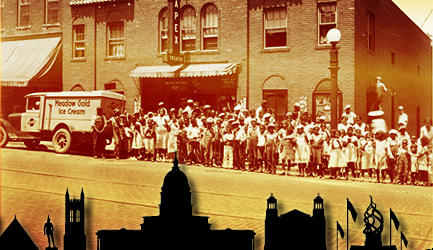Lost in the Stacks: Curse of the Narrows
 Only the crew of the Mont Blanc and a few others knew that the French ship carried high explosives as she sailed into the narrows of Halifax harbor on the morning of December 6, 1917: not the Imo, the Belgian Relief ship that accidentally collided with the Mont Blanc; not the witnesses in the harbor who saw the collision; not the spectators on the waterfront who stopped to watch the Mont Blanc in flames; not the hundreds of citizens, faces pressed against windows, who were fascinated by the lurid pink sky. When the Mont Blanc exploded at 9:04 a.m., over 2,000 people were killed, over 6,000 people were wounded, and 9,000 were left homeless. It was a disaster of epic proportions.Dazed survivors, many believing that the Germans had dropped a bomb on their city, frantically searched for loved ones among the rubble. It was a ghastly task: the explosion toppled buildings and houses with many people trapped or crushed in the debris; fire raged through the destroyed waterfront; live wires lay in the streets; broken glass was everywhere and bodies were strewn about, some beheaded by the shattered glass. To make matters worse, the explosion triggered a tsunami that added to the death toll, and to complete this terrible trifecta, a blizzard was on its way, greatly hampering the work of the rescuers.Curse of the Narrows, by Laura MacDonald, is an unforgettable account of the Halifax Disaster. She writes not only of the terrible explosion, the largest man-made explosion until the atomic bomb era, but also of the subsequent immediate and generous emergency response from the rest of Canada and many parts of the United States. In fact, each year the citizens of Nova Scotia send a Christmas tree to the city of Boston to thank the people of Massachusetts for their aid in that long-ago snowy December tragedy.
Only the crew of the Mont Blanc and a few others knew that the French ship carried high explosives as she sailed into the narrows of Halifax harbor on the morning of December 6, 1917: not the Imo, the Belgian Relief ship that accidentally collided with the Mont Blanc; not the witnesses in the harbor who saw the collision; not the spectators on the waterfront who stopped to watch the Mont Blanc in flames; not the hundreds of citizens, faces pressed against windows, who were fascinated by the lurid pink sky. When the Mont Blanc exploded at 9:04 a.m., over 2,000 people were killed, over 6,000 people were wounded, and 9,000 were left homeless. It was a disaster of epic proportions.Dazed survivors, many believing that the Germans had dropped a bomb on their city, frantically searched for loved ones among the rubble. It was a ghastly task: the explosion toppled buildings and houses with many people trapped or crushed in the debris; fire raged through the destroyed waterfront; live wires lay in the streets; broken glass was everywhere and bodies were strewn about, some beheaded by the shattered glass. To make matters worse, the explosion triggered a tsunami that added to the death toll, and to complete this terrible trifecta, a blizzard was on its way, greatly hampering the work of the rescuers.Curse of the Narrows, by Laura MacDonald, is an unforgettable account of the Halifax Disaster. She writes not only of the terrible explosion, the largest man-made explosion until the atomic bomb era, but also of the subsequent immediate and generous emergency response from the rest of Canada and many parts of the United States. In fact, each year the citizens of Nova Scotia send a Christmas tree to the city of Boston to thank the people of Massachusetts for their aid in that long-ago snowy December tragedy.












